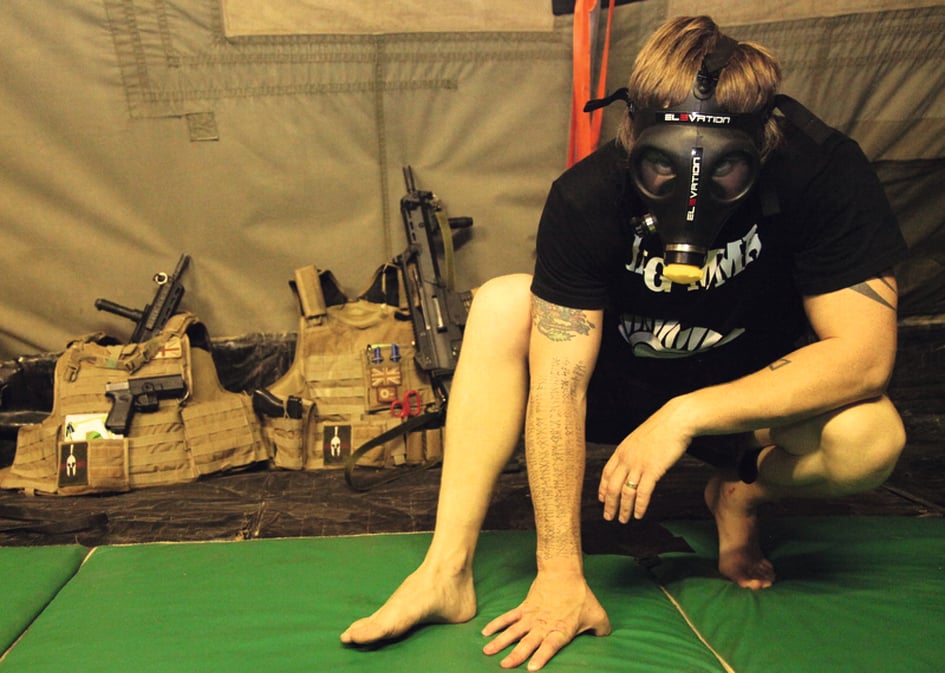
Issue 083
December 2011
Natural fear threatening to de-rail your performance? FO teaches you how to control it
?
Joe Bell
Joe Bell is a chartered sport psychologist and one of few leading mental performance coaches in the world specializing in combat sport psychology.
The first human reflex is to breathe. But for an alarming number of fighters, having that most basic survival instinct stifled by someone crushing, controlling and smothering them during an intense grappling session can have dramatic consequences if they are mentally unprepared for it. The sensation of claustrophobia and suffocation (considered as super-fears by psychologists) are more common among fighters than they would like to admit. In a desperate bid to gasp for air, an ancient part of the brain called the amygdala (a-mig-dala) kicks into overdrive as a response and instinctively pushes the body’s panic button causing fighters of all calibers to inexplicably gas, prematurely tap out or make deliberate mistakes to alleviate the psychological overload. However, with a few simple exercises we can begin to stop those outcomes being a reality.
If you experience involuntarily rapid breathing, racing heart rate and uncontrollable fear as a response to a prolonged feeling of being trapped or pinned against your will, it is not a weakness. It is millions of years of inherent instinct simply doing its job. The mind is preprogramed to keep you alive by any means necessary when it considers a situation life threatening. For example, fighters will know that being caught on the bottom in the north-south position with an opponent with a strong base will not kill you. But the catch-22: is, for some reason, something inside you screaming that it will? If you’re ticking this box you may need to reprogram your mind to override and control this powerful primal impulse.
As fighters we solve combat-specific problems (e.g. positioning, weight transference, submission availability, escape options) in the prefrontal lobes, the part of the brain that deals with logical and reasoning processes. It is what separates us from the animal kingdom and why we’re top of the food chain. Think of it as a command center that synchronizes all activity. However when panic fires up, information received by our senses reaches the amygdala twice as fast as it takes to get to the prefrontal lobes.

As a result of these different speeds in brain signals it means that unless a fighter instinctively knows how to react to a potential threat, they’ll panic as an initial response and are left waiting while the prefrontal lobes catch up to figure how to work through the problem. This is commonly recognized as the ‘fight, flight or freeze response.’
One solution to engage the prefrontal lobes faster and override the amygdala from pushing the panic button, lays in unconventional psychological techniques borrowed from the Navy SEAL mental toughness training program (adapted below). SEAL candidates are taught to overcome the super-fear of drowning through a series of trauma-inducing drills, which are designed to replicate the original phobic trigger until they finally become desensitized to it. We can apply a similar approach to MMA (see box).
Just because fighters don’t talk about it, doesn’t mean they rarely experience super-fears such as claustrophobia. Yes, some are naturally born with the ability to cope with the extreme levels of stress experienced in the Octagon, but most aren’t. The real issue here lies in fighters not checking their egos at the door and facing their fear head on. Remember, it takes a man to admit when he is afraid, but a stronger man does something about it. This will enable you to fight harder, dig deeper and last longer.
CRASH COURSE
Observe and Relax
Have a heavy training partner take top control on the ground, in ideally your most uncomfortable position whether it be mount, side control, knee ride or what have you. This stage is about relaxing, breathing and focusing on surviving the weight. Tune into their weight displacement and positioning and run through the variety of escape options. Now you are logically breaking down the problem and engaging the prefrontal lobes, thereby no longer acting on fear.
Survival and Escape
Same as left, but here your training partner gradually increases resistance and pressure. Once you have acclimatized, move onto escapes then submissions and finally all-out grappling. In psychology this process is called systematic desensitization and it doesn’t matter how long it takes to achieve (one day or one month) as it’s vital fighters feel confident at each stage before they move on if they are ever to override the panic button.
Survival Plus
Once you have conquered the above the advanced could try grappling with an Elevation Training Mask. All sensations described are magnified tenfold.
...









